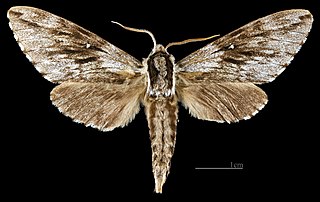Related Research Articles

Kentrochrysalis consimilis is a species of moth of the family Sphingidae.

Tethea is a genus of moths belonging to the family Drepanidae and subfamily Thyatirinae. It was first described by Ferdinand Ochsenheimer in 1816.

Tethea consimilis is a species of moth of the family Drepanidae first described by Warren in 1912. It is found in Asia, including the Russian Far East, Japan, Korea, Taiwan, Myanmar, Indonesia and India. The habitat consists of various types of mixed and broad-leaved forests.
Copelatus consimilis is a species of diving beetle. It is part of the genus Copelatus in the subfamily Copelatinae of the family Dytiscidae. It was described by Bilardo & Rocchi in 2002.
Candalides consimilis, the consimilis blue, is a species of butterfly of the family Lycaenidae. It was described by Gustavus Athol Waterhouse in 1942. It is found in Australia.
Aglossosia consimilis is a moth of the subfamily Arctiinae. It is found in the Democratic Republic of Congo, Malawi and Mozambique.
Scopula hesycha is a moth of the family Geometridae. It is found in Central China.

Onciderini is a tribe of longhorn beetles of the subfamily Lamiinae, they are prevalent across Europe in nations such as Turkey, and Finland.
Hesycha bimaculata is a species of beetle in the family Cerambycidae. It was described by Martins and Galileo in 1990. It is known from Brazil.
Hesycha clavata is a species of beetle in the family Cerambycidae. It was described by Martins and Galileo in 1990. It is known from Brazil.
Hesycha fasciata is a species of beetle in the family Cerambycidae. It was described by Martins and Galileo in 1990. It is known from Brazil.
Hesycha microphthalma is a species of beetle in the family Cerambycidae. It was described by Martins and Galileo in 1990. It is known from Brazil.
Hesycha biguttata is a species of beetle in the family Cerambycidae, known from Bolivia. It was described by Martins and Galileo in 2010.
Hesycha cribripennis is a species of beetle in the family Cerambycidae. It was described by Léon Fairmaire and Germain in 1859. It is known from Chile.
Hesycha crucifera is a species of beetle in the family Cerambycidae. It was described by Dillon and Dillon in 1952. It is known from Brazil.
Hesycha inermicollis is a species of beetle in the family Cerambycidae. It was described by Stephan von Breuning in 1940. It is known from Argentina and Brazil.
Hesycha strandi is a species of beetle in the family Cerambycidae. It was described by Stephan von Breuning in 1943. It is known from Venezuela.

Nothodelphax consimilis is a species of delphacid planthopper in the family Delphacidae. It is found in North America.

Neophylax consimilis is a species of caddisfly in the family Thremmatidae. It is found in North America.

Ramskoeldia is a genus of amplectobeluid radiodont described in 2018. It was the second genus of radiodont found to possess gnathobase-like structures and an atypical oral cone after Amplectobelua. The type species, Ramskoeldia platyacantha, was discovered in the Chengjiang biota of China, the home of numerous radiodontids such as Amplectobelua and Lyrarapax.
References
- ↑ BioLib.cz - Hesycha consimilis. Retrieved on 8 September 2014.